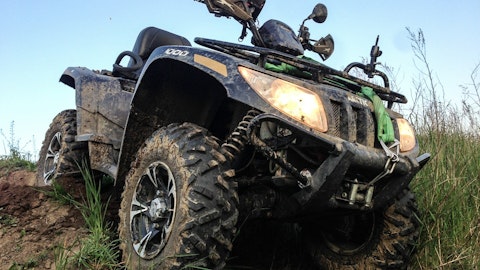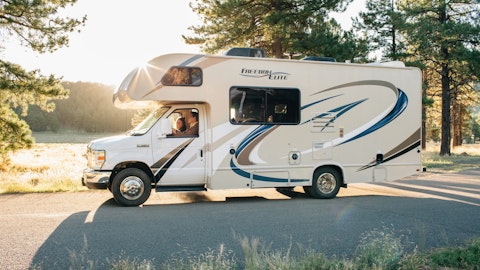BRP Inc. (NASDAQ:DOOO) Q4 2024 Earnings Call Transcript March 28, 2024
BRP Inc. misses on earnings expectations. Reported EPS is $1.81 EPS, expectations were $1.93. BRP Inc. isn’t one of the 30 most popular stocks among hedge funds at the end of the third quarter (see the details here).
Operator: Good morning ladies and gentleman, and welcome to the BRP Inc. FY ‘24 Fourth Quarter Results Conference Call. [Operator Instructions]. I would now like to turn the meeting over to Mr. Philippe Deschenes. Please go ahead, Mr. Deschenes.
Philippe Deschenes: Thank you. Good morning and welcome to BRP conference call for the fourth quarter fiscal year ‘24. Joining me this morning are Jose Boisjoli, President and Chief Executive Officer; and Sebastien Martel, Chief Financial Officer. Before we move to the prepared remarks, I would like to remind everyone that certain forward-looking statements will be made during the call and that the actual results could differ from those implied in the statements. The forward-looking information is based on certain assumption and is subject to risk and uncertainties and I invite you to consult BRP’s MD&A for a complete list of these. Also, during the call reference will be made to supporting slides and you can find the presentation on our website at brp.com under the Investor Relations Section. So, with that, I’ll turn the call over to José.
Jose Boisjoli: Thank you, Philippe. Good morning everyone, and thank you for joining us. Fiscal ‘24 was marked by sudden market share gain, successful product launches, and continued progress on our key strategic initiative. From a financial perspective, the year was more challenging than expected, due to macroeconomic environment. We adapted to the situation and as you know, we have proactively reduced our shipment to dealers. Despite unfavorable winter condition, which impacted our snow-related business, we’ve delivered EPS within our guidance range. Let’s turn to Slide 4. For key financial highlight for the year. Revenue increased 3% to reach $10.4 billion a record high for BRP. Normalized EBITDA was stable at $1.7 billion and normalized EPS was down 8% at $11.11.
Our focus on cash management payoff as we’ve delivered a record free cash flow of more than $1 billion for the year. As for retail, our North American power sports sales were up 8% for the year compared to an industry of about 1%. The strong power sport retail performance further strengthened our position as the number one OEM in the industry. As you can see on Slide 5. With this additional growth in fiscal ‘24, our retail now stands 35% higher than pre-COVID level in an industry that has been flat. We added another two-percentage point of market share for the year with gain across almost all product lines. We have continued expanding our leadership position as a number one OEM in PowersPorts, and the only one refilling more units per dealer than during COVID.
Our success comes from our ability to constantly innovate by bringing new product to market that drive consumer demand, and we are well-positioned to sustain our momentum going forward. Turning to Slide 6 for a closer look at our retail performance in the fourth quarter. Our North American PowersPorts retail was down 10% as we were facing a tough compatible due to late shipment and retail of three-wheel vehicle, personal watercraft and Sea-Doo Pontoon in Q4 last year. And yet, this year fourth quarter was our second strongest ever even surpassing the COVID year during which we had significantly depleted network inventory. Our performance was also impacted by unfavorable winter condition, which led to a snowmobile decline in the high teen, excluding snowmobile, our retail for the quarter was down only 2%.
Still, despite a more challenging dynamic in Q4, we are satisfied with our performance for the year. When excluding snowmobile, our retail was up 12% compared to the industry, up low single digit driven by a very strong performance in off-road vehicle and personal watercraft, and market share gain across most product line. Turning to Slide 7 for an update on global retail trend. As mentioned last quarter, we started to see gradual sign that the macroeconomic and environment was affecting our industry leading to softer market condition, especially in EMEA and Asia Pacific. The fourth quarter played essentially in line with this view, as we saw softer demand in EMEA and Asia Pacific, which we tell down 5% and 25% respectively. However, we had an excellent performance in Latin America driven by the Brazilian and Mexican markets.
Given these trends, we maintain a cautious approach entering fiscal year ‘25, our priority is to tightly manage network inventory to protect dealer profitability. Now let’s turn to Slide 8. For a year-round product revenue were up 9% reaching $1.4 billion in Q4, primarily driven by a favorable product mix and a return to normal shipment pattern for three-wheel vehicle. At retail, Can-Am side by side had its strongest Q4 ever being up low 20% firmly driven by solid growth in the utility category. Our performance is even more impressive as the first shipment of the new Maverick R occur late in the season. This brand-new platform already made its smart by winning the king of the hammer race in California two months ago, which would further stimulate consumer interest.
This strong quarter conclude another exceptional year for our side-by-side business, where we grew retail at the high teen percentage base and gain significant market share, especially in the utility segment. Our share reached 30% achieving the subjective a year earlier than our five-year plan. As for ATV, our retail was down low single digit as we lack a very strong Q4 last year. That said, we are pleased with the success of our new Outlander platform, which gained four point of market in the mid-60 segment. For the year, we gain almost two point surpassing the 20% mark for the first time ever and getting closer to the number two position in the industry. Looking at three-wheel vehicle, we are in the off season and Can-Am three-wheel retail was down high 20%.
The decline is primarily due to lapping and unusually strong quarter of retail last year as we ship unit later than normal in the season. Still given the interest of new entrant for the category, our strong lined up and enhancement to our Spyder F3 and RT models, we are well positioned to have a successful season. Turning to seasonal products on Slide 9. Revenue were down 28% from last year to about $950 million driven by a lower volume of products sold, resulting from a different timing of shipment compared to last year. Looking at our retail performance. For personal watercraft, this was peak retail season in counter seasonal market and Sea-Doo retail decline of mid-single digit in Australia due to market weakness. This was partially offset by impressive growth in the low 30% in Latin America, notably driven by the bra Brazil market.
As for North America, we are in the off season and retail was down primarily due to a difficult compatible given late unit shipment last year. However, from a historical perspective, retail is performing well a double-digit from typical for quarter pre-COVID level. This trend also continued in February, which gave us confidence for the upcoming summer season. Looking at snowmobile, as previously mentioned, fourth quarter retail was impacted by unfavorable winter condition in North America leading to decline in the high teen percentage range. I have been in the business for a long time and several challenging season, but is the first time that I see such difficult condition across North America. That said, looking at historical trend, we know that the snowmobile industry is very resilient and typically bounced back following weaker season.
We have a loyal and passionate customer base. Our Ski-Doo and Lynx brands are very strong and continue to outperform the industry with retail down low single digit for the season. Reflecting our commitment to bring innovation to market, we are strengthening our offering for model year ‘25 by introducing new feature and technologies across the lineup. Furthermore, we have launched two new Ski-Doo and Lynx electric models designed for multi-use application such as key center and recreational result. This model will also be available to consumers. With the strain of our lineup and recent edition, we expect to remain the number one industry player. Moving on to Slide 10 with Powersports accessories and apparel and OEM engine. Revenue worked down 23% to $291 million due to lower product shipment to reduce network inventory level and lower demand for snow-related replacement part.
Moving on to marine, revenue were down 32% to $84 million due to lower volume of boat shipment as dealer continue to be cautious about taking on inventory given weaker demand trends. Looking at retail sales, we are in the off season in North America and as my graph retail was down about 20% while Manitou retail was about flat. As for Quintex, retail was down about 10% in line with the industry. Looking ahead with softer demand in the boating sector, we are seeing more promotion across the industry. For this reason, we decided to be more conservative with our plan for fiscal year ‘25 in order to manage network inventory and preserve the value of our newly introduced folks. As such, we expect marine revenue to remain about flat for the year.
We are pleased with the customer reception of the new Manitou boat and remain confident about the potential of our marine business for the coming years. With that, I turn the call over to Sebastian.

Sebastien Martel: Thank you, Jose, and good morning, everyone. Our fourth quarter played out in a difficult context marked by unfavorable winter, which impacted our snow-related products and softening consumer demand in international markets. Still through it all, the team executed well to tightly manage shipments and network inventory levels, sustained solid market share gains and side by side and delivered bottom line results that ended within our guidance range. Looking at the numbers, revenue stood $2.7 billion, representing a decrease of 12%, primarily due to lower shipments and higher sales program notably, as adverse winter conditions affected our snow-related business and led to higher levels of promotions. We generated $653 million of gross profit with a margin of 24.3% down 130 basis points from last year.
This decline was primarily due to lower shipment volumes and higher sales program partly offset by a richer mix of products, favorable pricing and improved production costs. Moving further down the P&L, we generated normalized EBITDA for the quarter of $405 million and normalized earnings per share of $2.46. For the year we delivered normalized EBITDA of $1.7 billion, roughly flat to last year, and normalized earnings per share of $11.11, a decline of 8% from fiscal ‘23 resulting from higher depreciation and financing costs. Success in our industry comes from innovation, solid cash generation, and diligent allocation of capital, and we strongly believe this is a core strength of BRP. In that vein, as you can see on slide 13, fiscal ‘24 were the strongest year ever with over a billion dollars of free cash flow generation, representing a solid conversion ratio of over 60%.
Furthermore, we continue to prioritize investments in the business by deploying over $580 million in CapEx. These investments primarily focus on high-return growth projects aimed at sustaining our market share growth momentum, and expanding our addressable markets. Our solid ROIC of 30% for the year reflects our unique ability to innovate and deliver industry-leading results on projects. Given our solid cash generation, we also returned over $500 million to our shareholders to a 13% increase in the dividend, and by capitalizing on the dislocation in the value of our stock to repurchase about 6% of the shares outstanding. As our business is geared to generate solid free cash flow, we remain well positioned to continue investing in the business, all the while sustaining strong returns of capital to our shareholders.
Moving to an overview of our network inventory on slide 14. Our dealers’ inventory for the fourth quarter was up 36% from last year and up 30% from pre-COVID levels. As we mentioned. As we mentioned last quarter, despite that we diligently improved our inventory terms over the years. Our dealers are currently facing elevated inventory financing costs due to the increased dollar value of units and higher interest rates. To protect our dealer value proposition, we have decided to support them by aiming to reduce our network inventory levels by 10% to 15% this year. While there are opportunities for improvements across all product lines, the more pronounced decreases are expected to come from seasonal products in three-wheel, as they ended the respective seasons with higher levels of inventory than initially planned.
From a cadence perspective, Q1 network inventory is expected to remain high than last year as it comps overall leaner inventory levels and will be impacted by snowmobile given weather induced softer retail trends. From there, we expect a gradual improvement until year-end. Now moving to the guidance for fiscal ‘25 on slide 15. We are entering fiscal ‘25 with a solid lineup and an exciting pipeline of product introductions that are positioning us well to sustain our market share momentum in RRV and maintain our leadership position in seasonal products. From an operational standpoint, our manufacturing sites are running smoothly. The supply chain environment has normalized and we expect to continue benefiting from our lean initiatives and the expansion of our modular design across our lineup.
From a financial standpoint, our guidance essentially incorporates the global trends that have developed during the second half of fiscal ‘24, and that we have shared with you during our last earnings call, notably, softer consumer demand in certain international markets, weaker industry trends in marine limiting dealer’s appetite to take on inventory in a more elevated promotional environment. As previously mentioned, in this context, and in order to protect our dealer value proposition, we have decided to adopt a more cautious stance in our planning to reduce our shipments in fiscal ‘25. Additionally, given the impact of unfavorable winter on our snowmobile retail, we are planning to reduce our snowmobile production by about 30% for next season.
Accounting for all these elements, we expect our revenues for the year to be down from last year and end between $9.1 billion and $9.5 billion. In terms of profitability, we expect the headwinds from the reduction in volume to be partly offset by our richer product mix, favorable net pricing, and the aforementioned benefits of our cost improvement initiatives. Furthermore, we are taking the necessary actions to right size our operating structure in line with the expected revenue generation, limiting the pressure on our margin profile. As a result, we expect our normalized EBITDA to end between $1.37 billion to $1.47 billion. Our normalized diluted earnings per share to end between $7.25 and $8.25, including a headwind of about $0.90 coming from higher depreciation and financing costs, as well as a higher tax rate.
Note, that we are providing a wider than usual guidance range to account for the more than uncertain market environment, both in terms of consumer demand and promotional intensity, especially in the context of our aim of reducing network inventory levels. From a cash perspective, based on the above, and following a prioritization exercise of our project portfolio, which led to CapEx optimization, we expect to generate in excess of $750 million of free cash flow for next year. As such, we expect to have the financial flexibility to continue providing strong return of capital to shareholders. Notably, as we have announced a 17% increase of our dividend for fiscal ‘25. To conclude, we have provided a summary of the key drivers bridging our fiscal ‘24 results to the midpoint of our fiscal ‘25 guidance.
As you can see, most of the client in earnings is expected to come from volume and then mix as a result of our objective of improving network inventory return driving a net negative impact of $2.50, and from a reduction in the shipments of snow related products following a difficult season representing an impact of $1.25. Note that we expect most of the net reduction in volume and consequently most of the decline in normalized EBITDA to happen in the first half of the year with Q1 normalized debit down 35%. While fiscal ‘25 is expected to be a transition year from a financial standpoint at the midpoint of the guidance range, our normalized diluted EPS you expected to end above our original M ‘25 targets that we had launched in the fall of 2019 of $7.50.
Additionally, fiscal ‘25 is planned to be another year of exciting product introductions and continued progress and efficiency gains throughout the business. We strongly believe that the actions we are taking will position BRP for continued long-term success. And on that, I will turn the call over to Jose.
Jose Boisjoli : Thank you, Sebastian. While market condition as softened in the second half of fiscal ‘24, we were proactive and quickly adapted to the new reality. As mentioned in November, we have reduced our production volume in order to lower network inventory, and now in light of our Q4 results, we are adjusting snowmobile production for next year and taking a more cautious approach for Marine. We are known to be agile and we never hesitate to reprioritize our investment to find the right balance between the short, mid and long-term growth perspective. Looking at our EV plan, we have just launched two new electrics snowmobile model and we are looking forward to the upcoming launch of the Can-Am Electric motorcycle at our dealer event in August.
We remain committed to electrifying our product lines, but we have decided to deal with some of our EV introduction and we’ll provide an update in due time. In closing, I remain confident in our future. What we have in the pipeline is very exciting. As you know, the best part of my job is riding our product. I was at our test center in Florida two weeks ago and had the chance to try many future off-road personal watercraft, and both products, including some of our electric models. Again, I’m very impressed with the ability of our design and engineering team to come up with market shaping product and I look forward to introducing them to consumer. Innovation is at the core of our DNA and will continue to position the company for long-term success by pushing the boundaries of technology.
Our diversified product portfolio is a significant advantage, while our agile manufacturing network allows us to respond quickly to evolving market condition and still generate solid profitability. I want to thank our strong and resilient team for their hard work and dedication throughout the year. I also acknowledge our dealer for their support in making us the number one OEM in the industry, and we will continue to work in collaboration with them to further expand our leading position. On that note, I turn the call over to the operator for question.
See also 25 Richest Billionaires in Automotive Industry and 25 Most Taxed States in the US.
Q&A Session
Follow Brp Inc. (NASDAQ:DOOO)
Follow Brp Inc. (NASDAQ:DOOO)
Operator: Thank you, Jose. Ladies and gentlemen, we will now begin the question and answer session. [Operator Instructions]. And your first question will be from Sabahat Khan at RBC Capital Markets. Please go ahead.
Sabahat Khan: Okay, great. Thanks, and good morning. I guess, I think Jose, you made a comment about sort of managing the business for short, medium and long run. You know, we obviously have the guidance here for the upcoming 12 months, but a lot of the questions we’ve been getting have been around kind of the medium-term outlook for BRP and the industry. Can you maybe help us think through how you view, call it calendar ‘25 playing out, and just your view of how the industry evolves beyond this year and, maybe address some of the questions that people have had around, how are the current year sales and earnings compared to what might be the new run rate for the company? So maybe just some perspective on the, your forward-looking views of BRP and the industry.
Jose Boisjoli: Yeah, good morning. Just to give you a sense about the trend, the retail trend in February and March so far, and I will give you the number in North America without snowmobile, then retail is up mid-single digit, very good growth still in ORV, three-wheel is doing well. Water graph and switch is down, but we know it’s lapping abnormal quarter last year. And just to give you a sense of our retail momentum in the beginning of the year, our retail is about 50% above pre-COVID level. Then very happy with the retail trend. This is for North America, international, basically no change, soft in EMEA and APAC, and very strong in LATAM. Then this is the trend so far in February, March, and as you remember in ‘24 overall the, the North America industry was resilient with ORV in North America.
We saw softer international and marine overall is softer than for fiscal year ‘25 we planning this overall trend to continue then we’re planning North America to be down low single digit. A positive momentum for ORV and three-wheel will outperform snowmobile, obviously, watercraft and marine. And at international lagging North America. Then basically, we continue the trend that we saw in Q4 and what we see in February March is continuing for the remaining of fiscal year ‘25 with a downward of down low single digit in North America. Now that being said we have gained significant market share in the last few years, and our goal is to still, to continue to gain market share in the ORV business and maintain our solid leadership position on snowmobile and watercraft and continue to enter a new market segment, then that’s overall what I would see for retail trend.
Sebastien Martel: Yeah, maybe it is still early to call out what fiscal year ‘26 could be. Obviously as Jose said, we’ve got great momentum and I mean we’ve had peak retail for Q4 and side by side, just, and so that obviously is exciting. But for me, fiscal ‘25 is a correction year. And if you look at slide 16 that we have in the deck that we shared with you today, I mean there’s two elements that are for me are one-time elements that are hurting fiscal year ‘25, which is the adjustment of inventory for $2.50 and also the impact of snowmobile. So obviously we’re disappointed with the guidance that we have. We’d like to come up with a higher guidance, and if you take the midpoint of the range of 7.75, if you add these two one-time items, for me, fiscal ‘25 is almost more an 11.50 year than a 7.75.
We are doing what’s right for the business, what’s right for the industry, what’s right for the dealers, but obviously in the midterm, we anticipate that we will be producing results significantly higher than what we’ve announced today.
Sabahat Khan: Great. Thanks, so much for that.
Operator: Thank you. Next question will be from James Hardiman at Citi. Please go ahead.
James Hardiman : Good morning. Really like sort of the layout of that slide 16, I think it tells us a lot. So maybe using that is it three months ago you guys gave us your initial view on fiscal ‘25, and I think most people landed on about a $9 earnings per share number. Is it as simple as to say that since then that $1.25 is really what’s incremental in terms of the impact from the snowmobile-related products? And then you talked about that 2.50 also being one time-ish. Is the entirety of that just inventory draw down or wouldn’t there also be some sort of market related demand weakness, that ultimately gets worked into that 2.50 number as well? Just trying to make sure I understand how I should think about more of a normalized earnings number in a year where there isn’t significant inventory drawdown. Thanks.
Sebastien Martel: Yes. Well, on your first question, yes, you’re correct. What changed versus when we talked last November is the snow season. And so that’s the added headwind that we’re seeing of a $1.25. So, it, if I would say ‘25 is, aside from snowmobile is in line with what our views that we had a few months ago. And obviously in the 2.50, there’s a combination of inventory, which is a big one makes us favorable. That’s going to help obviously market share gains as well. But the bulk of the 2.50 is us being proactive in managing network inventory and protecting the EVP.
Jose Boisjoli: Maybe we’d like to add, when we had the call in November, we were ahead of our planning for the snowmobile retail and the momentum was good till Christmas time. And really the retail falls off mid-January about, and they never really catch up. Then this is the main reason of our adjustment.
James Hardiman: Got it. It’s very helpful.
Operator: Thank you. Next question will be from Martin Landry at Stifel. Please go ahead.
Martin Landry : Good morning, guys. I would like to touch on the snowmobile inventory in the channel. What’s the retail increase in inventory for snowmobile year-over-year, and how long do you think it’s going to take to flush out this the success inventory?
Jose Boisjoli: Yes, good morning, Martin. Just maybe to give you some highlight on the snowmobile season. If you look at the data of the last 15 years, basically, we saw a few bad winter in those 15 years. We say we estimate about three bad winter. And what is interesting is the snowmobile is very resilient. Customer are passionate about it. They accept now to trailer more to go to find snow. And Canada is about stable, maybe less riding in the — less retail in the heat, but more in the west. United States is slightly down. But if you look at the snowmobile business over the last 15 years, it varied between 95,000 units and 105,000 units per seat per year. In Scandinavia, in Europe – and in Europe and Europe is mainly commercial.
It’s about stable in the last 20 year at about 20,000 units. Then the point is, after a bad year, the industry typically remain quite stable because there is a lot of non-current into the flying pipeline. And there is customer that are happy to buy a new snowmobile at a discount. It’s sad to have this bad winter. It didn’t affect us on the wholesale, but obviously affected our sales program and our part and accessories and apparel. But we are confident that next year the industry will remain quite stable.
Martin Landry: Okay. Thank you.
Operator: And next question will be from Joseph Altobello at Raymond James. Please go ahead.
Unidentified Analyst: Good morning. This is Martin on for Joe. A quick question about the revenue decline in your guidance. It’s a little bit steeper than you implied three months ago. Was that the primarily Delta I’m sorry — Was that primarily the snowmobiles? And can you remind us of how big as apprentice set of sales is your snowmobile business?
Sebastien Martel: Yes, you’re right. When we look at the seasonal products business obviously impacted by snowmobile, the impact of the production adjustment that we’re doing, the 30% that we talk is going to be about a $350 million impact on our top line next year. When you look at the other elements of the guidance, where we missed the P&A business was off guidance that’s driven by the softer snow season where we sold less accessories, less parts as well because people were riding less. And oddly enough as well, we sold less winter accessories for our ORV business, such as track kits and plows that go in front of the ORV. In the other business where we missed the guidance was the marine business, where we are still seeing softness in the marine market as we’ve seen in the last say 12 months.
And dealers finish the season with more inventory and therefore they are more hesitant, especially early in the season to take on additional inventory, and so that’s why the volume impact resulted in a shortfall on the guidance.
Unidentified Analyst: Got it. Thank you.
Operator: Thank you. Next question will be from Robin Farley at UBS. Please go ahead.
Robin Farley: Thank you. Just circling back to your inventory goals, you mentioned, do you want to reduce it by 10% to 15%. It sounds like that was mostly in the snow and three-wheel. I don’t know if you clarified what you hope to do with side-by-side and ATV dealer inventory and then also on the retail side, just specifically for the side-by-side and ATV, what assumption are you working on for kind of industry retail as you’re trying to manage whatever inventory target you’re about to tell us for ORV?Thank you.
Sebastien Martel: The bulk of the decrease in the inventory is going to come from seasonal business, so personal watercraft, Sea-Doo Pontoon and also snowmobile. We will also be making greater adjustments on three-wheel. And in the on the ORV side, obviously, we have a very good momentum on ORV. As you saw, our retail performance in the fourth quarter was quite amazing. And so yes, we will adjust the inventory downward, but not as meaningful. It will be in the probably in the low single-digit adjustments for RV. In terms of industry, Jose gave a bit of color as well. The industry in good shape for side-by-side. Obviously, there’s been a lot of product innovation and that’s driving good retail, but we’re expecting a softer industry this year than we had. But obviously, market share gains will compensate and we expect retail to be up for side by side this year.
Robin Farley: So, you’re saying industry ORV retail has been good so far in the year, but you expect the full year to come in down year-over-year?
Sebastien Martel: To be softer than what we had in the last year, yes.
Robin Farley: Okay. Thank you, very much. Thanks.
Operator: Thank you. Next question will be from Cameron Doerksen at National Bank Financial. Please go ahead.
Cameron Doerksen: Thanks, very much. I guess my question is on capital allocation. So, I just want to confirm that you’d sort of indicated that you expect to generate something like $750 million in free cash flow in the year. So just want to confirm that number. And assuming that’s the case, just wondering about your capital deployment decisions here. Obviously, if you’ve redone your debt, just thoughts about NCIB substantial issuer bid, it would seem to me that you would have some excess capital if you do indeed generate $750 million of free cash?
Sebastien Martel: Yes, for the record, I confirm that I did say $750 million this morning. Obviously, we will be generating strong EBITDA CapEx in the range of $500 million, so obviously that will allow us to generate solid free cash flow. I’m not expecting any headwind or tailwind from working cap. There are still some opportunities, but with the management of the network inventory, probably see a bit more volatility on the working capital, so no tailwind there. But nonetheless, solid cash generation, which allows us to continue providing good returns to shareholders. As we have announced this morning, the dividend is increasing by 17%, and we will certainly be active on the NCIB, that’s our intention. We still got over 2 million shares that we can buy under the NCIB. So, we obviously want to deploy that capital towards that because we expect a certain dislocation in the share value in the current in the next few quarters.
Cameron Doerksen: Okay. Thanks, very much.
Operator: Thank you. Next question will be from Craig Kennison at Baird. Please go ahead.
Craig Kennison: Good morning. Thanks for taking my question. Seb, I think you mentioned some actions to address your overall cost structure in light of the difficult year ahead. I’m just wondering if you can help us quantify those actions and then maybe where they’re targeted, whether it’s in cost of goods sold or in your SG&A line?
Jose Boisjoli: Good morning, Craig. I will take the question. As you know, we said to the investor over the years that when slowdown happen, we prefer to be ahead of the game and be very agile to readjust. And like I said in my remarks, in my remark, in my script. I mean, we reprioritize many programs into the company. Then basically we feel that with the softer demand, we better to be prudent. That being said, I very confident that we have everything in line to be able to continue to gain market share in our key product line. But basically, we’ve done an exercise to reprioritize our project and that’s how we achieve lower OpEx than the what was originated plan a few months ago.
Craig Kennison: Thank you.
Operator: Thank you. Next question will be from Xian Siew at BNP Paribas. Please go ahead.
Xian Siew : Maybe also looking at slide 16, you kind of mentioned pricing net of sales programs, the $0.50 benefit, I guess, given a kind of more cautious outlook for the consumer potentially retail is down. What gives you the confidence on pricing?
Sebastien Martel: Well, every, obviously the inflation is still part of the business and running the business, and so we’re seeing cost inflation happening. So, we want to compensate that with some pricing. We will not be as aggressive and we don’t need to be as aggressive on pricing as we’ve been in the past. Inflation is coming down, but every year we do adjust pricing upward. We do expect the promotional environment to be more competitive this year. And so, we factored this in the guidance. We factored this year we’ve a tailwind of about 200 — headwind of about 200 basis point coming from promotion. We expect another 50-basis point next year. So that’s the next pricing and promotion. But again, we’re not thinking that the environment is going to be like fiscal ‘24. We’re expecting it more competitive and there’s more non-current inventory in the network that needs to be addressed as well.
Xian Siew: Got it. Thanks. And maybe just a one quick one. Just on gross margin versus SG&A. How are you thinking about within the guidance the EBITDA margin? It sounds like it’s mostly expense deleverage. Is that how we should think about it?
Sebastien Martel: There’s some expense de leverage plan, but if I look at the lower end of the guidance range, you’re probably going to lose a 100 basis points of gross margin. Probably coming from a bit more promotional and obviously the volume impact. And at the higher end of the guidance range, I’d say gross margin flattish to what we had in fiscal year ‘24.
Operator: Thank you. Next question will be from Tristan Thomas-Martin at BMO Capital Markets. Please go ahead.
Tristan Thomas-Martin: Good morning. Lot of talk about the snow headwinds is the potential of maybe a less snow warmer weather and early starts of season of tailwind for some of your businesses?




